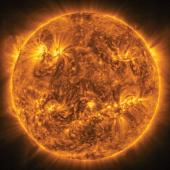Two to Tango
A great conjunction to winter's beginning.
Winter begins officially on December 21 with the solstice, although in Montana’s climate it will have started somewhat earlier for all practical purposes. But this year’s calendrical milestone is also marked by a rare conjunction of the greatest planets—or at least the largest.
On the evening of the 21st, go out a little after sunset—about 5:30 pm or so. Seek a good, low view of the southwestern horizon, and look into the fading glow of a likely frigid day. There, you’ll see planets Jupiter and Saturn in a rare lineup called a “Great Conjunction” just above the dusky landscape. The pair will appear less than a degree apart from our perspective, nicely fitting into the field of view of a small telescope or pair of binoculars.
The rendezvous is called “great” because it involves the two largest planets. While it happens predictably, it’s also rare, occurring approximately every 20 years—the time it takes the speedier Jupiter to trundle once around the sun in its orbit to catch up with and pass the slower, more distant Saturn. Jupiter will appear about ten times brighter than Saturn because it’s bigger and also much closer—a mere half-billion miles away compared to Saturn, which is twice as far. It’s worth seeing because these two planets haven’t appeared this closely lined up in space since 1623. And the conjunction won’t happen again until 2040.
On the evenings preceding, you can watch Jupiter overtake Saturn in the sky, closing the apparent distance, and on the evenings following, watch it leave Saturn behind. But don’t tarry; by the New Year, the pair will be very low and hard to see after sunset as the orbiting Earth puts the sun between us and them.
As long as you’re out looking, take a gander at Mars, located high in the south at nightfall—to the left and down from the Great Square of Pegasus the flying horse lying just south from overhead. The planet will be unmistakably bright and red, though it will fade like a dying ember over the winter as Earth leaves it behind from its October opposition, when it was closest and brightest.
If you have the binoculars out, sweep upward from Mars past the Great Square. A little up and left from the upper left corner of the square, you’ll find an oblong patch of faint light that is the Andromeda Galaxy, the nearest large galaxy to our own.
If you’re still out looking, turn eastward where you’ll find the small and compact Pleiades star cluster up in the east. Known as the Bunched Stars or the Lost Boys to the Blackfeet, its evening appearance was a signal to fill the figurative larder for the winter months to come, good advice even today. Look at it in your binoculars, and the field of view will fill with sparkling white stars.
If you wait a little longer, the familiar pattern of Orion will rise (visible earlier as winter passes), with his belt of three stars and a fainter line of three below it marking his sword. Aim those binoculars at the sword stars, and in the middle, you’ll see a faint haze of light: the famous Orion Nebula, known as Smoking Star to the sharp-eyed Blackfeet.
Then, trace a line along Orion’s belt down toward the horizon and find Sirius rising, the sky’s brightest star and the Wolf Star of the Cheyenne. Aim a little below the blazing white star and you’ll come across a tiny, faint patch of stars—the distant star cluster M41.
From a Great Conjuction to assorted binocular sights, the winter sky has much to offer. So bundle up, head out, and have a “Great” time.
Jim Manning is the former executive director of the Astronomical Society of the Pacific. He lives in Bozeman.










